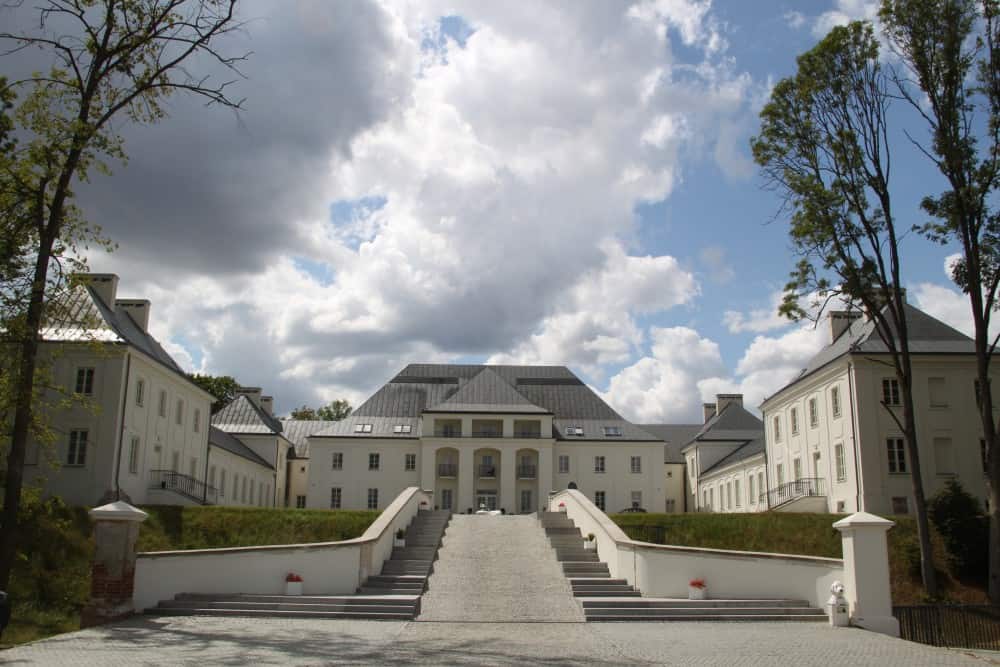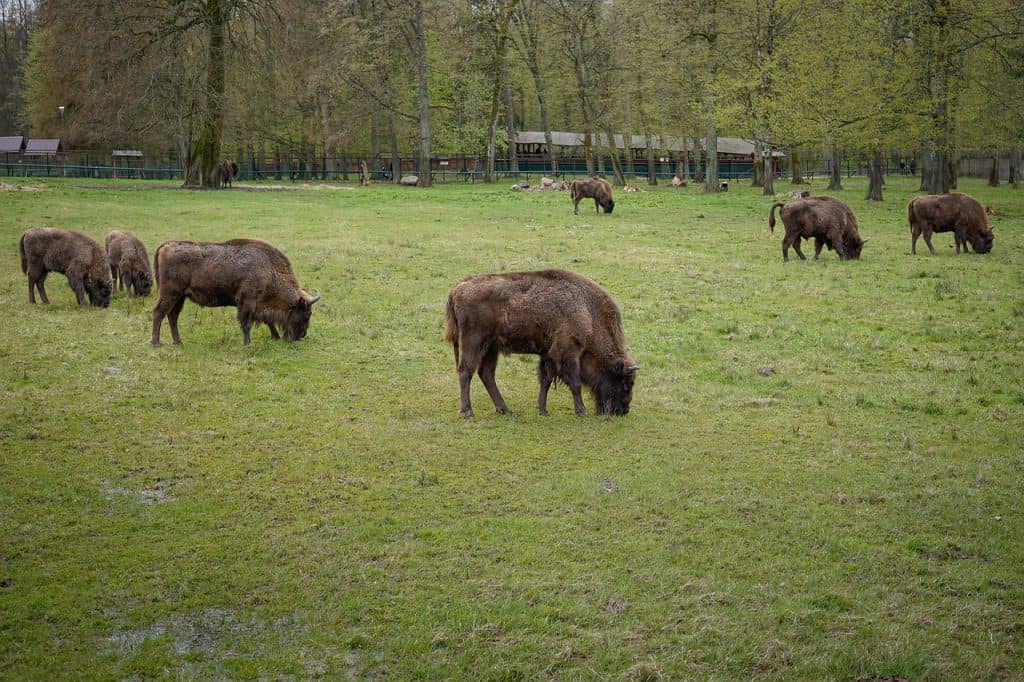The Podlaski Bug river valley Landscape Park covers several dozen kilometers long section of the Bug valley adjacent to the border with Belarus. The greatest landscape value of the Park is the ravine valley of the river, winding among moraine hills reaching several dozen meters in relative height. The unregulated, strongly meandering Bug crosses the belt of moraine hills formed during the Central Polish glaciation. The river valley itself is not homogeneous. In some places it is wide, with numerous oxbow lakes, wetlands and ponds, and in places it narrows and cuts deep into the surrounding uplands, creating slopes several dozen meters high. The denivelations here reach 85 m and are among the largest in the lowland area. The river valley is diversified, in places it is wide, with numerous oxbow lakes and tributaries, but there are places where the Bug narrows, cutting into the surrounding uplands, creating high slopes. The Bug River in its gorge is winding, at times high and steep, at other times gently sloping and sandy, or marshy and inaccessible. Another element diversifying the landscape are the valleys of the larger tributaries of the Bug which cut across the uplands. Within the Park, the following flow into the Bug: Krzna, Czyżówka, Sarenka, Toczna, Kołodziejka and Czapelka.

The Bug River is the axis of the park and the most important hydrographic element of this area. In the winding riverbed, we encounter deep pits, sandbanks, islands, and in the vicinity of the river oxbow lakes, which most often take the shape of a sickle. The largest of them are Buzysko near Stary Bubel, Duży Purwa near Borsuk and Trojan near Mierzwice. Natural erosive processes take place in the river bed, which consist in washing out the banks on the concave bends and the application of material on the convex bends. The left-bank tributaries of the Bug within the park are: Krzna, Czyżówka, Sarenka and Toczna. The stagnant waters include numerous oxbow lakes, small mid-field and mid-forest ponds, retention lagoons on the Krzywula River near Janów Podlaski and fish ponds in Cieleśnica.
Flora
In the watershed section of the Bug river valley, we can see coastal sandbanks and sand dunes, xerothermic grasslands, mowed meadows and the entire spectrum of forest areas, including alders, riparian forests, as well as marsh and water communities. The variety of park habitats contributes to the richness of the plant world. There are over 760 species of vascular plants in the Park. The most valuable representatives of the Park’s flora are: the gold-headed lily, the Siberian iris, the gladiolus, the common swarm, the flowerbed, the woodland eagle, the common spotted eagle, the club moss, the twinflower, the white cornflower and the red cuckoo.
In numerous oxbow lakes we can find fragments of submerged plant communities (e.g. knotweed, Canadian marsh, stiff tolls), floating on the water surface (partially protected white water lilies, coexisting yellow water lilies) and vegetation associated with shallow oxbow lakes (e.g. floating frogs and almonds). Sandy grasslands develop in more elevated areas – dry and sandy, often with a limestone base. The grassland communities are formed by dry-loving species and grasses, which form colorful carpets during the flowering period, such as cloves of polka dots and polka dots, sandworms, arachnid, sand thymus or sedum.
Fauna
The animal world is also rich, especially the avifauna. 141 species of birds have been observed in the Park. One of the most characteristic elements of the “Podlaski Przełom Bugu” Landscape Park are riverside slopes, which are an excellent breeding ground for birds nesting in sandy burrows: sand bank and kingfisher. On beaches and sandy islands, they nest, among others: ringed and river ringed plover, common sandpiper, white-fronted and river tern and gray gull. The common ringed plover, which is small, is an extremely interesting bird. It is characterized by interesting defensive behavior when the young are threatened: when a predator appears, the bird deceives it as far from the nest as possible, pretending to be sick, and when it comes to defending the eggs, it pretends to incubate them in other places in order to confuse the predator.

The most valuable place in terms of nature are willow and poplar riparian forests. This very capacious, rich in food habitat is a breeding place and shelter, among others for: stream batching, fire station, freaks, hoopoe, spinner. It is also worth mentioning that riparian forests play a very important role in preventing flooding. During floods, they reduce the speed of the flood wave, reduce lateral erosion of rivers and the amount of soil entrained during high floods, and are a natural sewage treatment plant, because plants growing in this area quickly absorb mineralized pollutants. Another important habitat for the breeding birdlife of the Bug valley are moist meadows, which are periodically flooded. The attractiveness of these places for birds depends on their extensive use. We can find here mainly waders: black-tailed moth, lapwing, common redshank and common snipe, which, probing soft ground with their beak, look for small invertebrates. There are also: Teal, Black Tern and Harrier. On the other hand, fish ponds and oxbow lakes are home to mainly birds from the crustacean family, adapted to living in a thicket of plants: spotted crake, green forage, aquarius and moor. On the open surface of the water, we can easily observe: red-necked grebe, mute swan, brown cap, tufted duck and mallard. The largest owl in Poland – the eagle owl and many species of birds of prey: lesser spotted eagle, honey buzzard, hawk, sparrowhawk, buzzard, nest in large forest complexes with an old tree stand. In addition, you can meet here a black stork, nutcracker, flycatcher, black woodpecker, medium woodpecker and a bruise, which, as the only pigeon in Europe, nests in hollows of old trees. Mammals in the Park are represented by otters and beavers, and a very rare wolf. The most endangered species of reptile is the pond turtle, which occurs sporadically in some oxbow lakes. The rare, strictly protected species of fish recorded in the Bug include, among others: white finned sausage and golden goat.
Cultural heritage
The most valuable monuments in the Park are located in Janów Podlaski, the former seat of the bishops of Łuck and Podlasie. The pride of the settlement is the baroque collegiate church, the bishop’s castle complex and the seminary building. An outstanding writer of the Enlightenment period, Bishop Adam Naruszewicz, was associated with Janów. Interesting monuments are the stable buildings of the first state stud in Poland – Arabian Horse Stud in Janów Podlaski, established in 1817. in the Wygoda farm. This stud, famous for breeding purebred Arabian horses, attracts many horse lovers from all over the world, not only for the August horse shows and auctions. In 2017, on the 200th anniversary of the Stud’s existence, it was entered on the list of Historic Monuments, which includes historic buildings of exceptional importance for the history and culture of Poland.

South Podlasie is an area where both Roman Catholic Poles and Ruthenians of the Orthodox and Uniate denominations live side by side. You can visit the former Eastern Rite churches in Stary Bubel, Gnojno, Krzyczew and Stary Pawłów. In Pratulin, we come across a sanctuary dedicated to the memory of those who died for the faith of Podlasie Uniates, elevated by Saint John Paul II to the dignity of the blessed. An extremely mysterious object is the so-called “Stone Baba” in Neplach – it is a large stone in the shape of a cross and at least of medieval origin.
Tourism
The area of the Park, due to its naturalness, beautiful, diverse, calm, clean water and healthy air, create an ideal place for recreation and relaxation for people who want close contact with nature. In the villages of the Bug, it is easy to find accommodation in numerous agritourism farms. It is best to traverse the park along the Bug trails – on foot or by bike (the Janów Podlaski-Hrubieszów Red Bicycle Trail, the Green Velo Eastern Bicycle Trail).

Within the park, there are two ferry crossings in the villages of Gnojno and Zabuże, which enable efficient access to the other side of the Bug. Moreover, for amateurs of more intense experiences, a canoe trail has been marked out on the Bug, which will allow them to get to know the Bug River and its elements from a different perspective.
The article comes from the portal http://parki.lubelskie.pl/


